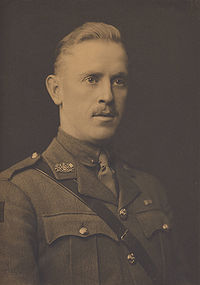Distinguished Service Order - Signals Recipients
From RCSigs.ca
The Distinguished Service Order has been awarded to the following 9 Signals personnel.[1]
| Name | Award Era | Award Date | Citation | Citation Image(s) |
|---|---|---|---|---|
| Maj A.A. Anderson | New Year award; 1918. No citation. | |||
| Maj G.A. Cline | New Year award; 1918. No citation. | |||
| Maj P.E. Earnshaw | New Year award; 1919. No citation. | |||
| Maj E. Forde | Awarded on the occasion of His Majesty's Birthday; 1916. No citation. | |||
| Maj F.A. Lister | Awarded on the occasion of His Majesty's Birthday; 1915. No citation. | |||
| Brig W.J. Megill | ||||
| Maj T.E. Powers | New Year award; 1917. No citation. | |||
| Maj G.M. Rolfe | Responsibility for maintenance of communications between H.Q. 6 Cdn Inf Bde and the Calgarys was charged to Major Gordon Rolfe, during the Dieppe operation 19 Aug 42. Landing with the initial attacking wave, in spite of intense enemy opposition he succeeded in leading his party to the appointed rendezvous. In a most exposed position he continued to maintain contact between ship and shore, keeping tank commanders informed as to the location of targets. When the withdrawal was ordered he was able to co-ordinate the defensive action of the tanks to cover the infantry evacuation. As a result of his direction the re-embarkation of the infantry was made possible. his distinguished service in this action was indicative of a high order of military skill and cool direction. [1 Canadian Tank Brigade Signals attached to 14 Canadian Tank Regiment (Calgary Regiment)] | |||
| Brig H.A. Young | Brigadier Young was in command of 6th Cdn Inf. Bde during the attack n St-Andre-Sur-Orne, which commenced 24 July, 1944. In the early stage of the battle heavy enemy resistance and counter-attacks resulted in very heavy fighting. Communications were disrupted and companies and battalions were separated from one another. Appreciating the importance of maintaining cohesion amongst foremost troops, and that his, and that his troops were fighting in their first major action, Brig. Young, without regard to his personal safety and heavy machine gun, mortar and artillery fire, visited forward battalions and companies and personally supervised the redisposition of units to ensure that counter attacks were repelled and a front established. When his Brigade Major was killed and another of his General Staff Officers was wounded, Brig Young, with little assistance, continued to direct the battle from forward position until it was successfully concluded on 26th July, 1944. By his personal courage, determination, endurance and example he so impressed the officers and men of the brigade that the attack was relentlessly pressed home and St-Andre-Sur-Orne was captured despite the bitter resistance. |
References
- ↑ Data compiled from multiple sources including The London Gazette, Library and Archives Canada, History of the Royal Canadian Corps of Signals 1903-1961 and Semaphore to Satellite
